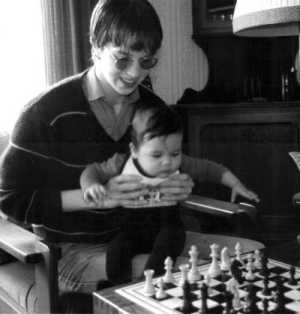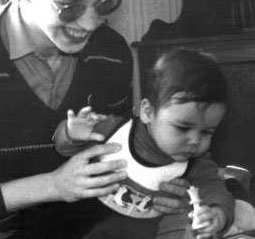ChessBase 2015 New Year's Puzzle Contest
We trust that you have enjoyed solving our 2014 Christmas puzzles, which were published from December 25 to 31. If you were meditating in a cave in the Hindu Kush mountains during that week and missed them, do not worry: you can review the problems by clicking on the images below, which will take you to specific instalments.
Now to our puzzle challenge. We give you three full weeks to solve the following problems – and perhaps win a very nice prize. This will consist of recent ChessBase software, with autographs of top players – at least one a World Champion or ex. And the first prize will probably come with a personal dedication. Note that we have selected puzzles that are not easily accessible to computer solving. What is the point in giving positions that modern chess engines solve in their first seconds of thought? Note too that by some freak accident of the Universe all three problems were provided to us by puzzle king John Nunn.
Puzzle one: How can it be a draw?
This is the nice little problem I received from John in 2001: White has a king, a queen and two pawns against Black's bare king. It is White to move, but he cannot force a win. The game is drawn. Can you reconstruct the position? The problem has an additional stipulation "White is not stalemated".
Solution: Here is a position that fulfils the conditions. White to play cannot do anything about the stalemated black king. The game is a draw.

At the time, December 2001, we received a number of solutions with the above position (or reflected on the left side of the board). It would therefore seem that this is a unique solution.
When the problem was originally proposed by John Nunn a chess player named Jens Späth of Tostedt, Germany, noticed that you can even add a few queens to the above position:

Out of curiosity we asked you to think about how much material White can have against the bare black king, be on the move and still not be able to win. There are many ways to do it with a full white force. Joshua Green of Arizona sent me the following position:

Even though it is White to move the position is a draw, as any move stalemates Black. The position is in fact legal: Black’s last move was Kb1-a1 and White’s last move was, say, Bd3xPc2+. Black’s previous moves consisted of moving his king back and forth between a1 and b1 while White calmly promoted all his pawns to queens and moved his pieces to their current squares. With this idea, it is easy to construct a proof game. This is clearly the maximum possible material difference.
Puzzle two: en passant mate
Our second New Year's puzzle was: What is the shortest game ending with an en passant capture and mate? It is clear that both sides will be cooperating to bring about an en passant capture with mate. Solution: just six moves!

[Event "?"] [Site "?"] [Date "2014.12.28"] [Round "?"] [White "Zlatanov/Benko, Angel/Pal"] [Black "Shortest game with e.p. mate"] [Result "*"] [ECO "C00"] [PlyCount "11"] 1. e4 (1. d4 e5 2. dxe5 d5 3. Kd2 Bg4 4. Qe1 d4 5. Nc3 Bc5 6. e4 dxe3# { Zoltán Laborczi}) (1. f4 e5 2. Kf2 b6 3. h3 Bd6 4. Kg3 Bb7 5. Kh2 exf4 6. g4 fxg3# {Dragan Bukvich}) 1... e6 (1... e5 2. Qh5 Nc6 3. g4 d6 4. g5 Kd7 5. Bh3+ f5 6. gxf6# {Pal Benkö}) (1... f5 2. exf5 Kf7 3. Qg4 Qe8 4. b3 h6 5. Bb2 g5 6. fxg6# {Crisan Vlaicu/Koen Eeman}) (1... d5 2. d3 dxe4 3. Kd2 Qd4 4. Nf3 g6 5. Ne1 Bh6+ 6. f4 exf3# {Gregor Werner}) 2. e5 Nh6 3. Qh5 Ke7 4. Nc3 g5 5. Ne4 f5 6. exf6# {Zlatanov} *
Crisan Vlaicu of Cluj-Napoca and Koen Eeman of Denderleeuw, Belgium, sent us a six-move solution (above) which we did not know. Zoltán Laborczi of Budapest, Gregor Werner of Worms, Germany and Dragan Bukvich of Vrsac, Serbia, sent us moves in which White is mated – in one half-move more than in the other solutions.
Puzzle three: A logical challenge
A hermit occupies one of six caves. Every day he randomly switches to an adjacent cave. Every day we search one cave. Is there a strategy to ensure we will find him, whatever switches he makes? How many times must we search a cave?
Solution: A good strategy for solving the problem is to start with three caves and work your way up:
- Three caves: searching in cave 2, 2 finds the hermit.
- Four caves: search 2, 3, 3, 2 finds him (or symmetrically 3, 2, 2, 3)
- Five caves: 2, 3, 4, 4, 3, 2 and 2, 3, 4, 2, 3, 4 and (plus 4, 3, 2, 2, 3, 4 and 4, 3, 2, 4, 3, 2)
- Six caves: 2, 3, 4, 5, 5, 4, 3, 2 (and 5, 4, 3, 2, 2, 3, 4, 5)
"The key lies in confining the devious hermit in an even-numbered cave on an odd-numbered turn (or vice versa)," wrote Victor Lee of Singapore. "The cave puzzle becomes easier after figuring out that we can divide solution in two parts," wrote Vasil Hristozov of Bulgaria, "depending on initial position (odd/even) of the hermit. We need to search 2x(n-2) times for n>2, in our case: 8. 2-3-4-5 will ensure finding him, if the initial position was even; then 5-4-3-2 will catch odd starting positions."
John Nunn told us that he had proved that the only eight-day solutions to the six-cave hermit problem are 23455432 and 54322345. "I would expect that the analogous 2n-4 day solutions are the shortest to the n cave problem (where n is even), but I don't see an easy way to prove this," he wrote. One of his early desciples, Thomas Friedel, wrote a brute force program to check all possibilities, which, he says, "is also a kind of proof". Here are all the fastest solutions for seven caves:
- 2, 3, 4, 5, 6, 2, 3, 4, 5, 6
- 2, 3, 4, 5, 6, 6, 5, 4, 3, 2
- 6, 5, 4, 3, 2, 2, 3, 4, 5, 6
- 6, 5, 4, 3, 2, 6, 5, 4, 3, 2
"After that it takes pretty long to check, but the pattern probably continues," says Tommy.
Bonus puzzle four
 |
In this picture you see a real child prodigy, one who started playing chess at an unusually early age. This chess prodigy went on to become a very strong grandmaster, one of the best in the world. Tell us who he is.

|
In December 2001 we got many solutions from readers who identified the infant grabbing the chess pieces in the pictures as Garry Kasparov, Anatoly Karpov, Judit Polgar, Peter Leko, Vassily Ivanchuk, Michael Adams, Evgeny Bareev, Alexander Morozevich, Peter Svidler, and some others. This time the wrong guesses included Radjabov, Karjakin, Nunn, Reshevsky, Carlsen ("it seems to me that the woman on the picture bares resemblance to his mother" wrote N.P. of Montenegro), Alekhine, Kasparov, the very young Nigel Short ("who has clearly inherited the smile of his mother" – V.A.A. Brazil)
Wrong! The infant is my son Tommy, who later on in fact went on to play tournament chess, but was never a true chess prodigy. But then, who said the prodigy we were trying to identify was the infant?
The honest-to-goodness chess prodigy, the one who was whipping everyone in town at the age of six, who played in GM tournaments at 12, and who actually went on to become a World Championship challenger, is the person holding the baby! It is the 16-year-old Nigel Short, who decided to see whether a ten-month-old child could learn the game he so excelled at.
Some feedback from our readers
Here are a few of the literally hundreds of letters we received. The selection was made on a semi-random basis, so do not feel offended if your message was not included. You can add it to our discussion section at the bottom of the page. There will be one additional prize for the nicest contribution there.
Olya Ivanenko, Ukraine, Nikolaev city
I think lovely boy on the photo is Teimour Radjabov. The man something looks mysteriously like Nigel Short. However its hardly it can be he.
Yoony Kim, New Haven, CT
These puzzles are nice because you can't just flip on the engine and find the answer in less than a second.
Jochen Keller, Cologne, Germany
This year’s puzzles in general were not the hardest ones for someone solving them for many years already. My wife kept wondering why I gave up so early every morning. When I told her that I didn’t give up but had solved them she was very confused, as she was not used to that. Probably my relatively fast successes were caused by the hours I spent with similar stuff 20 to 30 years ago: I not only read Smullyian's two volumes on retro analysis, which I really loved very much, but also a small volume called “ABC des Schachspiels” which appeared in Eastern Berlin (if I remember correctly) and contains a lot of curious stuff, for example the Mate starting with 0-0-0 on the a-file. The prodigy: we have all read that people like Kasparov, Nunn, Short and so on visited Frederic Friedel's house regularly, but it seems unlikely he invited a little baby who went on to become a strong GM soon. So the prodigy looked for must be the one holding the baby, who seems to be the young Nigel Short. Remembering many good days!
William Wang, Pittsburgh, Pennsylvania, USA
These puzzles have been a great workout for my brain!! I'm sure they will become a future tradition there will be a Christmas puzzle season in our house!!
Michael Jones, King's Lynn, UK
Many thanks for another wonderful selection of many and varied puzzles, which have become an established part of my Christmas ritual; this year's compilation delighted, entertained and baffled me in turns.
Donard Tiannok Amen, Gumban St. Pavia, Iloilo, Philippines
ChessBase is the only site that I don't miss to visit whenever I'm online. From the latest top-level tournament news to valuable annotated games, interesting features and instructive puzzles, ChessBase always entertains me. Most of all, ChessBase offers the strongest chess engines and databases that were always on top of my wish list. Truly, ChessBase is every chess player's desire.
Max Enkin, Peabody, MA, USA
Thank you very much for 15 years of Christmas puzzles! I always look forward to them and they are such fun to solve as a break from University studies! Chess puzzles really show the beauty of chess and it always interests me how the simple chess pieces that we have known for so long can still do amazing things given the correct position. Thank you again, and I am looking forward to next year's puzzles!!
Daniël Wium, Bloemfontein, South Africa
I would like to thank Chessbase for all the interesting articles, which I have been following daily since about 2005. I often use the articles as material for coaching sessions at my local club, Bloemfontein Chess Club, in central South Africa. We are very isolated in chess terms, much more so than Mitchells Plain, where our first Grandmaster, Kenny Solomon, originates from. If I were to win one of the prizes, I would probably be the first member of our club to own the ChessBase software, and I promise to put it to good use. Thank you once again for all the articles and the challenging puzzle questions.
Olav Bakke, Oslo, Norway
Thanks for posting these wonderful puzzles for us to solve. I have very recently become a father for the first time, so unlike previous years I do not have all the time I would like to dedicate myself to these puzzles. Therefore I was happy to read that only one correctly solved puzzle was needed to be eligible for the Prize Contest. To my further great delight, I was able to easily solve two of the puzzles without noticable distraction from family duties already on the first day of the year.
Manan Rai, New Delhi, India
Well, ChessBase is the best International Chess News Website. It is fabulous, and I must say sir Frederic made my Christmas and New Year amazingly exciting with me sitting down every day with the chess board and solving those lovely helpmates and studies. This was the first time I worked on them, and I'm sure its the start of a wonderful journey!
Laszlo Antal, Fuzesabony, Hungary
It has been pleasure to solve your puzzles. Please follow this tradition and post puzzles next year too.
Winners
We promised that two winners would be chosen at random from all eligible submissions – we like to reward participation, not getting everything meticulously right. A third prize winner would be selected on the basis of the nicest message (in our opinion) that we received. So here they are:
- Laszlo Antal, Fuzesabony, Hungary
- Rainer Kuhn, Worms, Germany
- Daniël Wium, Bloemfontein, South Africa
The three prize winners must send us their postal addresses in the next few days? We will be attending the Grenke Classic and the 2014 Zurich Chess Challenge – which means there is an excellent chance that they will get personalized dedications from some seriously strong players.





































